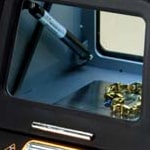Money check
As a precious metals professional, we use a variety of procedures to test and verify the authenticity of sterling silver when buying it back. Depending on the situation, we use one or more tests before buying back silver. Here are the main tests to determine whether silver is genuine.
Silver inspection with the naked eye
To authenticate silver easily, the first thing we do to know if your silverware is not silver-plated is to observe it. We can sometimes see particular signs that indicate or give us a clue as to whether the silver is solid or not, such as a silver hallmark attesting to the quality of the silver contained in the object (Minerve, Lion, sterling...) or directly the silver grade in thousandths (800, 900, 925, 999). In general, a square hallmark with a number inside designates a silver-plated metal object. See "Silver hallmarks" for more information.
The condition of edges, corners or protruding sides which may show discoloration due to exposure to wear and oxidation, revealing a metal other than silver; this is the case when silver-plated metal is used.
Testing silver with acid
When eye contact doesn't determine that an object is silver-plated, we still have to test for silver with acid. This is an essential test.
Given the difficulty of obtaining this acid, and the safety risks inherent in carrying out this test at home, it's best to leave it to a professional.
The first way to proceed is to rub the object to be tested on a "touchstone", so that a few milligrams of silver are deposited.
Put a drop of acid on this mark and observe the reaction to the acid; a bright red mark indicates fine, dark red 925, brown 800 and green 500 thousandths.
Another, more advanced process involves filing off a non-visible part of the object to remove the top layer and apply the acid directly to it. This process is more commonly used to test silver, as the layer on silver-plated metal is much thicker than that on gold-plated objects, for example.
Silver spectrometer test
 A spectrometer is a measuring device used in spectrometry to break down an observed quantity into its simple elements, which make up its spectrum. For the silver testWe use an X-ray fluorescence spectrometer. When the test object is bombarded with X-rays, the material re-emits energy in the form of, among other things, X-rays, and the X-ray spectrum is characteristic of the sample's composition. By analyzing this spectrum, we can deduce the elemental composition, i.e. the mass concentrations of elements, and thus verify the silver concentration contained in the precious metal test object. This silver test is particularly effective for recognizing raw silver in the form of silver nuggets.
A spectrometer is a measuring device used in spectrometry to break down an observed quantity into its simple elements, which make up its spectrum. For the silver testWe use an X-ray fluorescence spectrometer. When the test object is bombarded with X-rays, the material re-emits energy in the form of, among other things, X-rays, and the X-ray spectrum is characteristic of the sample's composition. By analyzing this spectrum, we can deduce the elemental composition, i.e. the mass concentrations of elements, and thus verify the silver concentration contained in the precious metal test object. This silver test is particularly effective for recognizing raw silver in the form of silver nuggets.
This silver test enables precise analysis of silver alloy purity in a matter of seconds, without damaging the sample.
Check whether the metal is magnetic
While this test is easy to perform, it is neither infallible nor universal. It is generally used as a complementary test to check silver coins, or if an ingot is not filled with a magnetic metal. A magnet as weak as a refrigerator magnet will be useless to you. Instead, you'll need to use stronger magnets found either in DIY stores, or in everyday objects such as ladies' handbag latches, toys or even disused hard drives. Silver is not a magnetic metal, so it will not be attracted to the magnet. If the object is attracted to the magnet, then it's not real silver. However, the fact that it doesn't react to the magnet doesn't mean you're dealing with genuine silver, because other non-magnetic metals are also used for counterfeit coins.


You must be logged in to post a comment.